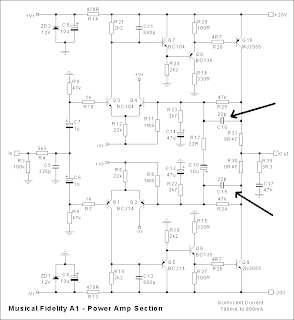Used my spare NOS Russian 6N23P-EV(s) for this project - as per my Musical Fidelity Tubalog. Other components include the Audiophiler and Wima's (red and yellow "bars") for signal path, EPCOS for non-signal path, Nichicon MUSE (outlet recommendation), and Rubycons.
I began using a regulated "off-the-wall" PSU 12V 500mA to power the PCB. Sounded terrible with much "audio breakage". When I contacted the DIY outlet, they informed the original design was based on a unregulated PSU e.g wavely line vs bar with 3-dots above on the PSU. Sounded much better once fed the proper diet!
 |
| 2nd iteration |
On my 3rd iteration, I replaced the 1st two filter caps with a single Rubycon. The "yellow" Wima was replaced with a larger value Silver Mica.
Wundabar!!! Everything fell into place.
 |
| 3rd iteration |
 |
| Another view of 3rd iteration |
Forth iteration. Replaced the Rubycon 10uf with Panasonic FC 22uf, as these were on the signal path. Sounds rich and life-like thru the Luxman L410, especially the piano pieces.
Update#1
I found the following schematic from the web and updated it with the changes made. The shaded area is the section which is in the signal path. Changes are in red text. The shaded area of the schematic clearly shows the audio signal path and I personally believe money should be spent on components in the shaded area. I tried better components in the unshaded area before and there were minimal improvements except for the upgrade of the power filter caps from 1000uF to 2200uF. I used 16V instead of the original 35V as I measured the voltages at these points and were below 16V. Using 2200uF resulted in a quieter background in the output e.g when you are next to speakers and no music was playing. And I did not use the 4007 diodes as per the schematic as I had many IN4004 leftover from my Quad 33/303 upgrades.
 |
| Schematic with changes |
Update#2 - 27Sep2012
Both channels died and the valves do not glow anymore.
Checking the power section of the PCB reveals the 2.2R 2W resistor to be faulty and when tested shows a value above 400ohm.
Replaced the 2.2R 2W did the job!











